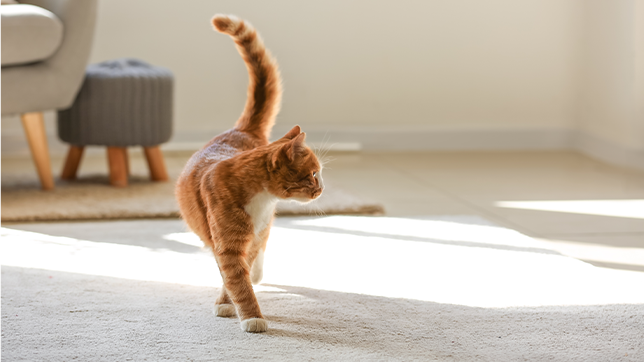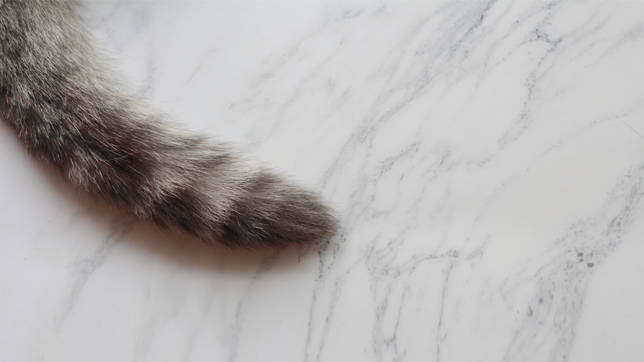18th December 2023
Why your cat wags their tail: Four reasons explained

Cats are notorious for their mysterious behaviour, and one of their unique gestures is tail wagging. While we might associate tail wagging with dogs, feline tail movements carry their own unique significance and meaning.
In this article, we delve into the world of feline communication, exploring why cats wag their tails and what it might mean at different times of day!
Why do cats wag their tails - is there a ‘language’?
Cats are amazing communicators, and their tails play a crucial role in expressing how they’re feeling and what their intentions might be. You can use their tail movements to gauge their mood and read the various messages they might be signalling to the other animals and humans around them.
They may wag their tail to let you know they’re annoyed, scared, happy or playful, but their tail can also be a sign of affection. By paying attention to your cat’s tail and its different wags, you can usually get an idea of how they might be feeling.
Different types of tail wagging (and what it means)
Here’s a list of possible explanations as to why your cat is wagging their tail to help you decipher their emotions and, hopefully, understand what they’re trying to tell you.
Slow, gentle wagging
A tail held high with a gentle sway from side to side could mean that your feline friend is feeling content. Sometimes, you might notice a slight curve (a bit like a question mark) at the end as it sways slowly to signal their happiness.
It might not be as obvious as a dog’s wag, but it’s a subtle way of letting you know that they’re feeling good.
Why not use this as an invitation to interact with your cat and engage in some play time with them?
Rapid, agitated wagging
On the other end of the spectrum, rapid and agitated tail movements can indicate irritation, anger, or overstimulation. If your cat's tail is low and stiff and its wagging consists of thrashing and lashing, it's a clear sign that they may be feeling stressed or annoyed.
Remember: Approach with caution, as your cat may not be in the mood for interaction.
Puffed-up tail
A puffed-up tail is a defensive posture as they attempt to make themselves appear larger and more intimidating to scare off any potential attackers. This tail will often be accompanied by raised hair along the ridge of their arched back, and possibly some hissing!
If you spot this stance in your feline, they might feel threatened or frightened, so be sure to give them space to calm down.
Quivering tip
A slightly quivering tip of the tail can express excitement or anticipation. You might see this tail when your cat is focused on a prey item (like a toy), or is about to engage in play with another cat, and it’s usually followed by a pounce.
Cat tail wagging while sleeping
Observing your cat's tail movements while they're asleep can be entertaining and intriguing, as you wonder what they might be dreaming about. While it might seem like they're having a grand adventure in the land of nod, it's more likely a result of the cat's unconscious muscle movements.
This is because cats can experience rapid eye movement (REM) sleep, during which their brains are highly active, and they might exhibit certain behaviours such as twitching of their eyes, ears, paws, and tail.
Do all cats wag their tails?

While tail wagging is a common behaviour among our feline friends, not all cats exhibit this trait in the same way and might use other forms of communication. Some cats may use their tails more expressively than others, and the intensity and frequency of tail wagging can vary, based on the individual cat's personality, experiences, and even their breed. So, don’t panic if your feline friend isn’t a tail-wagger, it’s completely normal!
Much like their meows, cat tail wagging is a fascinating aspect of feline communication, helping provide some insight to their emotions. By paying close attention to your cat’s tail movements, you can develop a better understanding of their feelings and intentions. So, next time you spot a wag in your cat’s tail, take a moment to consider what they might be trying to tell you, so that you can hopefully avoid any surprise swipes or nasty nips!
Looking for more cat advice?
We’ve written some handy cat advice guides, to help you unlock the secrets of your mysterious moggy.
Need cat insurance?
Cat insurance can help cover the cost of veterinary treatment if your cat gets injured or falls ill.
We know pets
Our pets are part of the family. To achieve our vision of a better future for pets everywhere, we work with our partners, vets, and other veterinary professionals who are pioneering the latest advancements in animal care. Our campaigns, articles, and events are crafted to support, educate, and celebrate pet owners, while our policies are designed to provide peace of mind at an affordable price.
Yet our policies don’t just protect against the unexpected – they have purpose, too.
Since we were founded over 25 years ago, we've provided industry-leading policies that protect the nation’s pets, while also making a difference to animal welfare and our planet. Thanks to you, our policyholders, we've donated over £9 million to more than 830 animal welfare charities and conservancies, helping to support vulnerable pets and wildlife around the world.
We’re proud to be wildly different. Are you?
